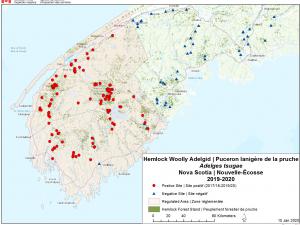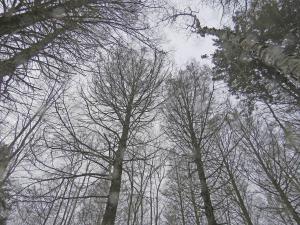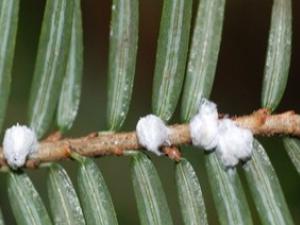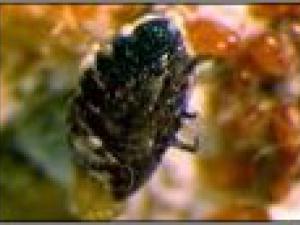What is HWA?
Hemlock woolly adelgid (HWA) is an invasive, aphid-like insect native to eastern Asia and the Pacific Northwest. HWA was first reported in Canada in British Columbia in the 1920s, and it was detected in Southwestern Nova Scotia in 2017. The first Eastern North American detection was in Richmond Virginia USA in 1951, on an ornamental hemlock from Asia. It is not known at this time how HWA came into Canada, and the exact source will be difficult to determine. Dispersal of HWA occurs by wind, storms, hurricanes, birds, animals, and human movement of nursery stock, logs, and other wood products, including firewood.
HWA is different than most of the insects found in the Northeast in that it is dormant through much of the growing season and active throughout much of the winter. HWA immatures (crawlers) settle onto twigs by mid-August and dormant. They neither feed nor develop during this period, until mid-October, when they come out of dormancy and resume feeding until approximately early March. As adults, they will now begin to produce eggs surrounded by ribbons of a white, waxy material that appears as small cotton balls lined up at the base of the needles. This is when most people become aware of their presence. These eggs will hatch, and a new generation will begin feeding. These crawlers will mature in late-May to early-June, another batch of eggs is produced, and the cycle begins again. All HWA are females and the vast majority of these are wingless.
HWA can cause defoliation, twig dieback and mortality in as few as 4 to 10 years, though it can take up to 20 years. All hemlock sizes and ages are vulnerable to attack. HWA is naturally spread by wind, birds and mammals. Long distance dispersal can occur via infested nursery stocks, logs and firewood.
HWA are all female and reproduce asexually. They have two generations per year, living their lives entirely on hemlock. In its native range, HWA has a winged sexual generation that flies to spruce trees, but this stage does not survive on North American spruce species.
Click here to learn more about the life cycle of the HWA and how that impacts management strategies.
The HWA feeds on the storage cells at the base of the needle, eventually killing the needles and buds and causing needle loss and stem dieback. In the late summer months the newly settled HWA crawlers (sistens) go through a period of dormancy called aestivation, where its mouthparts have been inserted but they are not actively feeding and developing. Once HWA breaks aestivation, they are active throughout the fall, winter, and spring, accumulating the wool that gives it its name. The wool protects the developing HWA, insulating it from cool winter temperatures and sheltering it from natural enemies, and ultimately creating an ovisac in which to lay eggs.









